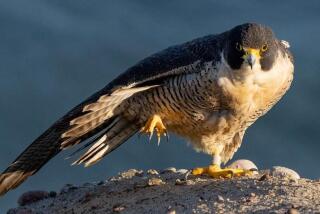A Year-End Review: Tying Up Some of the Loose Ends From ’84 : Hope for Endangered
The local population of endangered peregrine falcons grew modestly in 1984 and a falcon family that resides on the Union Bank Building downtown acquired greater solidarity with humans, thanks to the participation of several thousand Times readers who entered a contest to name them last summer.
As the year ended, however, there was both good and bad news for people concerned with the ultimate survival of the peregrine as a species and the immediate well-being of local falcons.
The good news is that sometime this spring there will probably be two breeding pairs of mature falcons ready to produce young in Los Angeles. They will include the adult Union Bank birds--Free Spirit (the female) and Equity (the male)--as well as a reconstituted breeding pair on the California Federal Savings & Loan Building at 5670 Wilshire Blvd.
The California Federal Savings peregrine nest suffered the mysterious apparent death of the female in the pair sometime last year. But the male bird remained in the area and a few months ago another female flew past, noticed him and landed to set up housekeeping.
The Union Bank birds raised two young in 1984--but the chicks were not their own. When bird experts noticed that the two adults were inexperienced in handling their eggs and inadvertently kicked one off the ledge where they nest, a team of humans moved in and removed Free Spirit’s eggs, substituting two young already hatched at a captive breeding center in Santa Cruz.
One of the young, a female named Hawkeye, crashed into a building on one of her first flights and had to be returned to Santa Cruz to recuperate from a broken wing. She will remain there. But the second young, a female named Angela, survived and became an adept flyer. Like all peregrines her age, she has left the nest and apparently flown to Mexico for the winter.
The bad news, however, is that when scientists examined Free Spirit’s eggs, they discovered worrisome indications that the female bird has been contaminated by DDT, the pesticide that has been responsible for the significant drop in the peregrine population. Placing peregrines in the city where they presumably would dine on urban pigeon is a major premise of the nationwide urban falcon program.
The problem, said Lloyd Kiff, director of the Western Foundation of Vertebrate Zoology, which runs the program locally, is that urban falcons cannot be forced to stick exclusively to a pigeon diet. On top of that, Equity has turned out to be an unusually fast flyer, even by the standards of the peregrine, a species routinely capable of attaining speeds of as much as 200 m.p.h. in the steep dive that precedes a kill.
Equity is so fast, in fact, said Kiff, that he hunts swifts, a small species itself known for such speed that it has been thought almost uncatchable, even for the peregrine. Swifts, however, have become one of Equity’s favorite foods and, said Kiff, swifts, unfortunately, are also often tainted by DDT, which they can absorb in a variety of ways even though the pesticide is no longer legal for use in this country. DDT is still used in Mexico, and swifts migrate there, Kiff said. There are also traces of the chemical in the soil and throughout the food system to which peregrines can be exposed.
The implications of the deterioration of Free Spirit’s eggs worry Kiff--she eats prey killed by Equity. “Breeding is still very depressed because the egg shell situation (in general among peregrines) is as bad as it’s been since the early 1950s,” Kiff said.
Equity and Free Spirit will be forced to adoptive parenthood again this year. Their eggs will be taken from them as soon as they are laid and captive-bred young substituted. The California Federal Savings birds will be given an opportunity to hatch their own, but they will be closely watched, as well, Kiff said.
More to Read
Sign up for Essential California
The most important California stories and recommendations in your inbox every morning.
You may occasionally receive promotional content from the Los Angeles Times.










